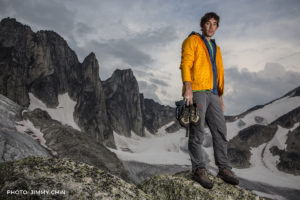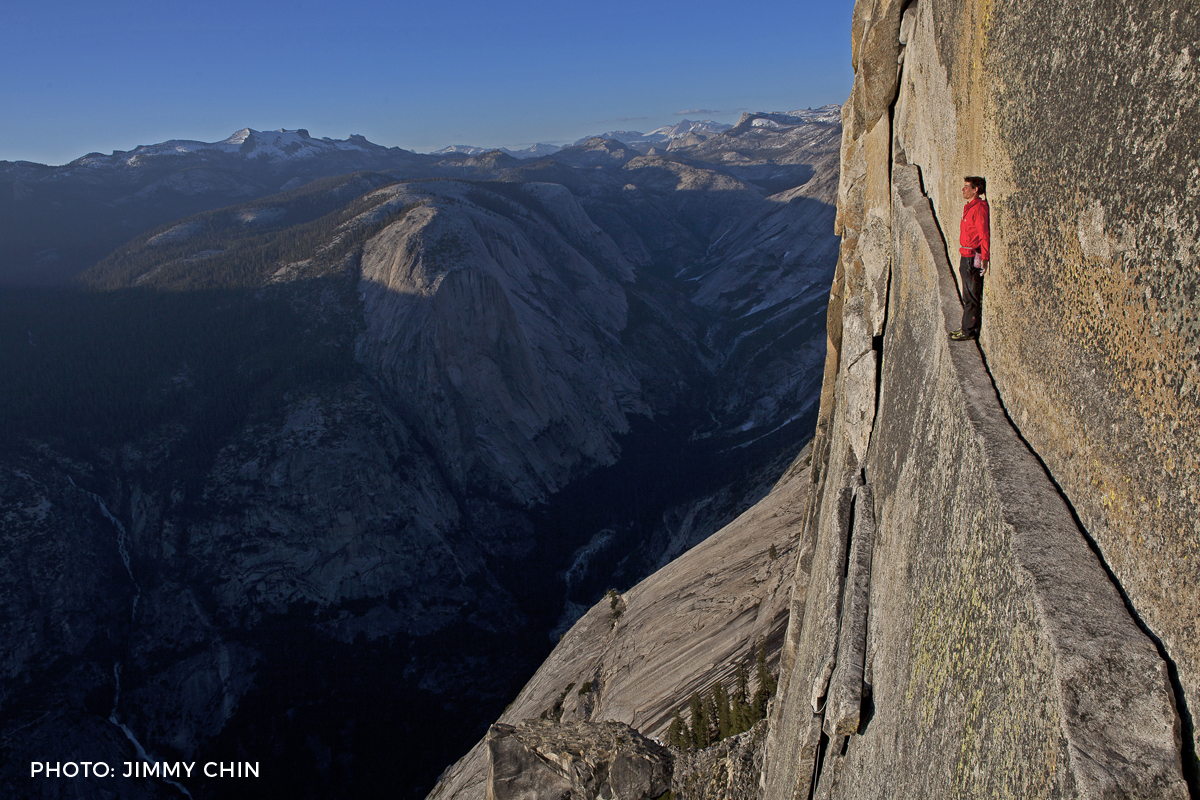Greatest living rock climber. Lone master of Yosemite Valley’s most terrifying ascent. That’s Alex Honnold.
Propelled by wiry strength, secured with chalk-dusted fingers, sticky-soled climbing shoes and months of keen, Zen-like choreography on the same escarpment, Honnold stunned even the climbing world last June, ascending nearly three thousand feet along the granite face of Yosemite’s El Capitan in less than four hours. Alone. No ropes. No safety equipment.
“May be the greatest feat of pure rock climbing in the history of the sport,” exclaimed National Geographic magazine. “One of the greatest athletic feats of any kind, ever,” mountaineering author Daniel Duane asserted in The New York Times.
Honnold, 31, held a sell-out crowd of 550 people in awe, laughter – and frequent gasps — while recounting his daring El Capitan saga this month at the American Himalayan Foundation annual dinner. It was both witty narrative and gritty analogue on the universal virtues of chasing — and achieving — a long-held dream with precision planning, extreme physical effort and flawless, fearless execution.
Here are lightly edited highlights:
**
“I had dreamed about El Cap for eight years. I didn’t know if I’d feel comfortable. I didn’t know if I’d have the inspiration. What I did know was that I wanted to put in the work and to find out if it is possible.
“Last year was when I decided, ‘OK, it’s time to start the real process.’ ”
“When I showed up in Yosemite with Conrad (Anker, renowned Himalayan climber and mountaineering guide), it was historically wet in California and El Cap was full of water. Terrible conditions. But, I had a lot of pre-planning work ahead.”
“Early in the (winter) season we climbed all the way up the planned route. We would climb half the route, clean out some rocks, load them in a backpack, take out some bushes, crawl back down to the grass and then do it again. Basically hard physical toil. That sounds stupid. Not sexy, not core, but the kind of work you just have to do if you want to be able to climb El Cap.”
**
“Later, I spent day after day up there going up and down the wall (with ropes), touching the wall, trying to memorize moves: ‘Should I put my left foot up first, or should I put my right foot up first? How would you balance? How would you actually do that?’ ”
“I was marking things with chalk for sequences, then realizing I didn’t want to go that way and erasing the chalk, (then) realizing I did want to go that way, and putting the chalk back.”
“There were a lot of sections on the route where I had to improvise, so I would feel safe, feel comfortable. I had to figure out how to position my body, my pushing muscles.”
“The hardest point is sitting in the van, visualizing, trying to internalize all these things I’d learned. It’s one thing going up the wall one a day, memorizing and figuring out movement. But actually remembering two thousand feet of movement later takes quite a bit of time to think it through. ‘Was it the left hand? Was it the right hand?’ It’s a lot of moves.”
**

“It’s one thing to have a dream. It’s one thing to hope it happens someday. But at some point you actually have to start doing the work.”
“I was thinking even until the very end, ‘Oh, I don’t have to do this. There is no pressure on me to do this if I don’t really want to. I’m just trying to set myself up to see if it is possible.’ ”
“And, ultimately, I find out that it is in fact possible. It was (pause) … pretty exciting.”
**
A climber’s glossary: “Free climbing … means climbers use no gear to help them move up the mountain and are attached to ropes only to catch them if they fall. Free soloing is when a climber is alone and uses no ropes or any other equipment that aids or protects him as he climbs, leaving no margin of error.” – National Geographic magazine.
** **
Several breathtaking accounts of Alex Honnold’s El Capitan masterpiece, his climbing career and other free-soloing gems are accessible on the internet. Heart-stopping videos as well.
Here are six, with links and brief excerpts:
“The Heart-Stopping Climbs of Alex Honnold,” by David Duane, The New York Times Magazine. March 12, 2015
- “Even if you have perfect confidence in your climbing ability and perfect emotional control in the face of danger, as Honnold appears to, most climbers fear the unexpected: the handhold that suddenly breaks, the bird that erupts from a hidden nest.”
“Alex Honnold’s Perfect Climb,” by J.B. MacKinnon, The New Yorker. June 9, 2017
- “Sketchy rock—and Freerider has a lot of it—demands balance, body control, and composure. It sets the ultimate standard: perfection, or death.”
“El Capitan, My El Capitan,” by David Duane, The New York Times. June 6, 2017
- “When I asked Honnold’s mother (Dierdre Wolownick) how she tolerated her son’s climbing life, she told me that at some point she realized that she couldn’t live with worrying all the time. ‘Alex is the only one on the planet who knows what Alex can do, and I’ve had to learn to just trust that.’ ”
“Exclusive: Climber Completes the Most Dangerous Rope-Free Ascent Ever,” by Mark Synnott, National Geographic magazine. June 3, 2017
- “For more than a year, Honnold has been training for the climb at locations in the United States, China, Europe, and Morocco. A small circle of friends and fellow climbers who knew about the project had been sworn to secrecy.”
“The Ascent of Alex Honnold,” CBS 60 Minutes. October 2, 2011
- “What you are about to see is someone holding onto a wall, thousands of feet above the ground, with nothing to stop him if he falls.” – Correspondent Lara Logan
Interview with “Jimmy Kimmel Live!” ABC-TV. July 14, 2017
- “Climbing is such an individual sport. You have to choose your own challenges and push yourself in whatever way you want to. I’m inspired by these big walls and I’m inspired by doing them by myself.” – Alex Honnold
** **
Photo credits: Jimmy Chin, courtesy of the American Himalayan Foundation


Leave a Reply